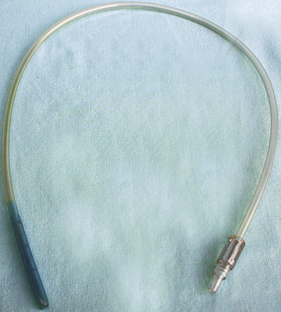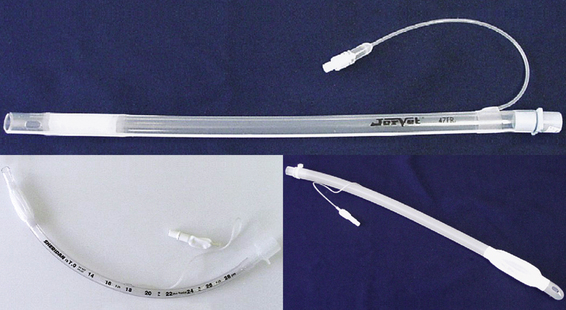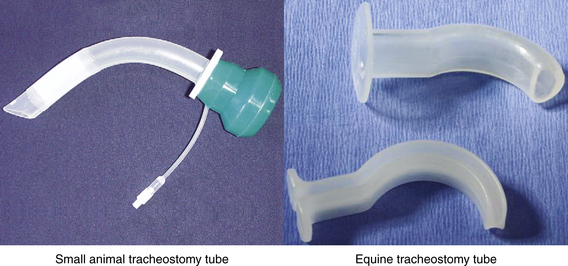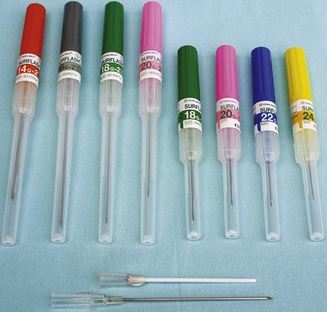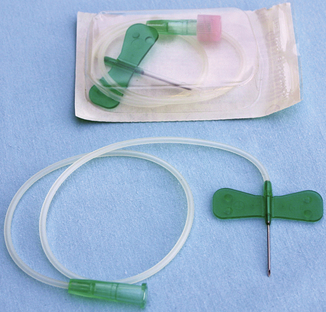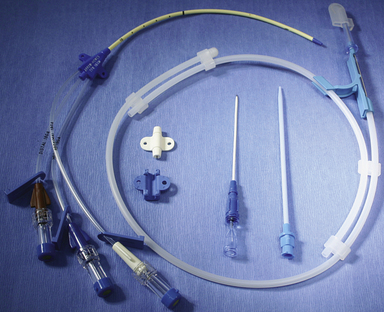CHAPTER 7 Tubes and Intravenous and Urinary Catheters
A variety of tubes and catheters are used in veterinary medicine to help patients recover from injuries, illnesses, and surgeries.
INSTRUMENT
Esophageal Stethoscope
| FUNCTION | To allow the heartbeat to be heard; it is useful during procedures that require anesthesia. |
| CHARACTERISTICS | This long flexible tube has a rounded end that is inserted into the esophagus until it rests beneath the heart. The other end is attached to a speaker device that makes the beating of the heart audible. This stethoscope can be used only in animals that have been anesthetized. It comes in a variety of sizes, which are measured by the French (Fr) scale; from smallest to largest, 12, 18, and 24 Fr are available. |
INSTRUMENT
Endotracheal Tube
| FUNCTION | To establish an open airway to deliver gas anesthesia or oxygen. |
| COMMON NAME | Trach Tube, ET Tube |
| CHARACTERISTICS | A flexible tube available in a variety of sizes that range from 1 to 14 mm internal diameter. A cuff, which is on the end of most tubes, is used to seal the tracheal opening after insertion of the tube; this prevents the animal from breathing around the tube and prevents fluids from entering the lungs. The cuffs may allow use of a large or small volume of air, which is delivered via a one-way valve attached to the side of the tube. The tubes are made of silicone, PVC, or red rubber. |
INSTRUMENT
Tracheostomy Tube
| FUNCTION | To establish an airway through the tracheal wall in a patient that has an upper airway obstruction or is critically ill. |
| CHARACTERISTICS | A short tube that can be left in place on a short- or long-term basis. It may be cuffed or uncuffed and is made of silicone or silver-plated metal. Sizes range from 2.5 to 3 mm internal diameter. |
INSTRUMENT
Indwelling Intravenous Catheter
| FUNCTION | To establish a port into a vein or artery to deliver intravenous (IV) fluids. |
| COMMON NAME | IV Catheter |
| CHARACTERISTICS | A flexible catheter is placed over a needle or through a needle. The needle is used to puncture the skin and vessel; the catheter is then threaded into the vein. The needle is removed after the catheter has been placed. The catheter has a standard hub that receives the IV drip set or syringe tip. The hub is also used to secure the catheter to the animal’s body. Sizes range from 24-gauge × ¾ inch to 10-gauge × 5¼ inches. They can be made of polyurethane, Teflon, or Pebax or of nonreactive polyurethane for long-term use or stainless steel for use in large animals. |
INSTRUMENT
Intravenous Butterfly or Winged Infusion Sets
| FUNCTION | To establish a port into a vein to deliver IV fluids or to draw blood samples from very small animals such as rabbits and kittens. |
| COMMON NAME | Butterfly Catheter |
| CHARACTERISTICS | This catheter has a standard 1-inch needle that is inserted into a vein. The wings are used to secure the catheter in place. The long tube on this catheter must be filled with fluid before insertion; otherwise, that air will be introduced into the vein when the fluids are attached. This catheter is easy to place but difficult to keep in place because of the needle. |
< div class='tao-gold-member'>
Only gold members can continue reading. Log In or Register to continue
Stay updated, free articles. Join our Telegram channel

Full access? Get Clinical Tree


